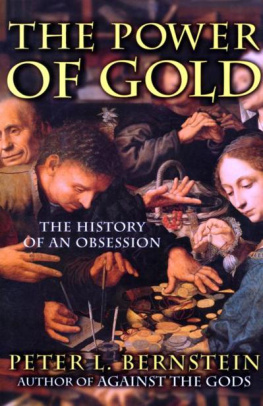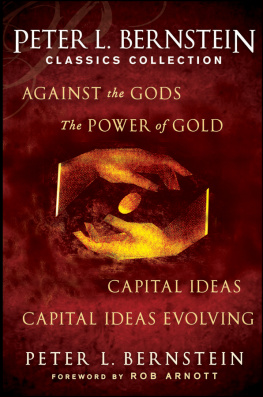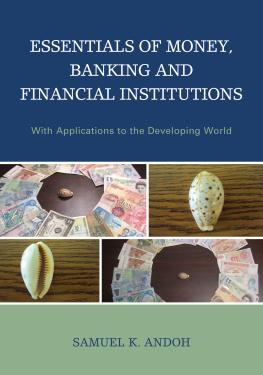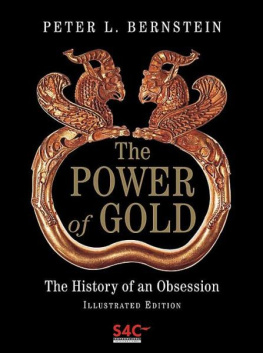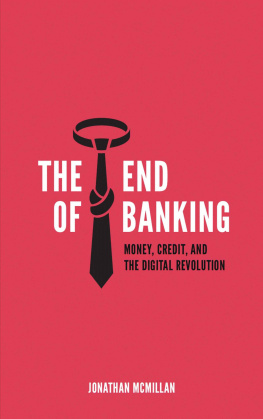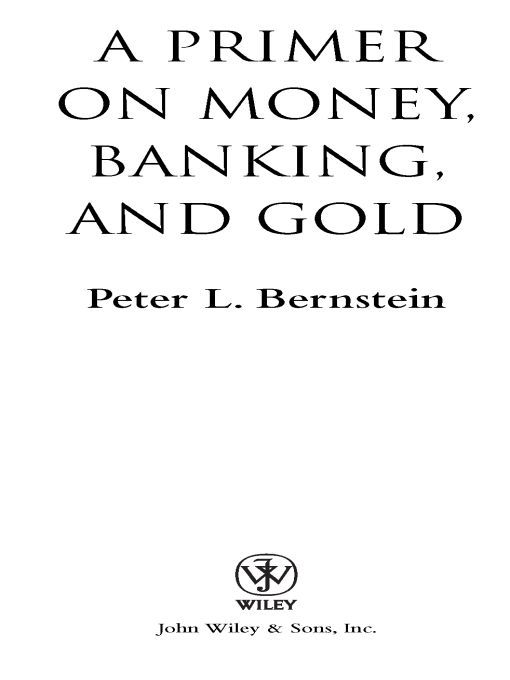Table of Contents
For
My mother
What is here?
Gold, yellow, glittering, precious gold?
...This yellow slave
Will knit and break religions; bless th accurst;
Make the hoar leprosy adored; place thieves,
And give them title, knee, and approbation
With Senators to the bench...
Timon of Athens, IV, 3
FOREWORD
Ah, for those days before globalized markets, before thousands and thousands of hedge funds, huge banking conglomerates more interested in investment banking than holding loans and attracting depositsa world without CDOs and SIVs, mysterious conduits, and sub-prime mortgages!
That simpler world existed just a generation ago. Peter Bernsteins little Primer on Money, Banking, and Gold described it all with analytic insight and with his typically lucid prose.
The details of what he described in the late 1960s may seem arcane and mostly irrelevant to the new breed of financial engineers, to traders mesmerized by their Bloomberg screens, and even to some of todays central bankers. After all, who today patiently analyzes the weekly Federal Reserve statement for clues as to the direction of monetary policy? For that matter, that statement isnt carried any longer in the financial press. All the details have been lost about Federal Reserve float or currency in circulation, matters about which I, as a neophyte Fed staffer, once considered myself to be one of the worlds leading experts.
Today, the Federal Reserve authorities set out their current policy objective for all to see with some precision in a written statement after every meeting of its Open Market Committee: the interest rate for Federal funds shall be x percent until further notice. There is a brief commentary about the reasoning behind the decision, and more often than not, speeches and statements of the Committee Chairman and members. Its all open and transparent, with the stated objective of reducing uncertainty in the marketplace and enhancing policy effectiveness.
But does it really? Those of us of a certain vintage have some doubts. We may know the intentions with respect to the Fed funds rate objective with great precision, but divining the market and economic outlook and the future of policy remains as shrouded in uncertainty as ever. We can even wonder whether, by so precisely determining a simple controllable interest rate at a particular point in time, something has not been lost. In the simpler days of the 1980s and before, we thought there was something to be learned as the tenor and force of market flows had some influence on the day-to-day or week-to-week interbank interest rate.
One thing is certain. What Bernstein, writing at the end of the 1960s perceived as our highly developed and sophisticated financial system has become much more complex. Given the lack of transparency of the highly sophisticated instruments and market practices, characteristic of much of the new financial system, one is forced to question whether the underlying reality has been obscured. Traditional commercial banks with a unique function at the center of the financial system described in the book have morphed into a partsometimes subsidiary partof much more diversified and internally conflicted institutions. The definition of money itselfand of liquidityhas blurred, matters that Bernstein, with his usual insight, recognized as an emerging reality decades ago.
Even more clearly, he foresaw that the role of gold as the centerpiece of the international financial system would need to give way to less rigid arrangements. Indeed, it is clear that Bernsteins purpose in writing was, in large part, to chip away at the golden foundations of the monetary system. In fact, that foundation soon crumbled, less by chipping away than by being overwhelmed by a financial tsunami.
But amid all those specifics, what sticks out in a reading of Bernsteins Primer is what has not changedand those are matters of fundamental importance. They remain, in fact, at the center of debates about monetary policy today. Beyond the books relevance to those of historic bent, it is those matters that make rereading the Primer so timely.
Bernstein deals at some length with questions of whether inflation is a great threat to the American economy, whether once entrenched at a low level it will insidiously tend to accelerate, and whether monetary policy by itself is well equipped to deal with it.
Writing from the perspective of the 1960s, Bernsteins answers are pretty clear: no, no, and no again. He counts on the enormous productivity and resiliency of the American economy to cope with, and diffuse, exceptional inflationary pressures that might arise from time to time as a result of war or other events. When all is said and done, the productivity of the American economy is the ultimate barrier to inflation in our country.
Bernstein goes on to suggest that post-World War II experience and cool analysis alike suggest that a little inflationsay 1 percent a yearwill not lead to anticipatory buying or destabilizing speculative behavior. And one senses what is most important in his mind is a balancing of risks for the maker of monetary policy: there is a clear danger that tight money in an attempt to deal with inflation might feed on itself, encouraging precautionary demands for money almost impossible to satisfy. The potentially catastrophic consequences for the economy will and should outweigh concerns about accelerating inflation.
Sound familiar? With only the slightest change in language (e.g., substitute liquidity for money), it might be an op-ed piece in todays press.
Would Bernstein have been quite so emphatic, quite so confident about experience, if he were writing just a decade later, say in 1979? As he had argued, gold was gone as part of the monetary system and as an ultimate (and unduly rigid) restraint on money growth and inflation. To a threatening extent, so was confidence in the dollar as a store of value and as the centerpiece of the financial system. Our capacity to restrain an inflation that had reached double digits and to maintain strong economic growth in the midst of speculative distortions was in question.
Our level of economic understanding and sophistication of monetary management that Bernstein judged as so much more advanced in 1968 no longer seemed to provide relatively painless answers in an environment of stagflation. Nor did we avoid a serious recession when monetary policy finally was called upon to deal with an inflation that had become embedded in expectations. But severe as that recession was, the reestablishment of reasonable price stability surely helped revive the base for much more satisfactory economic performance.
In the wake of that experience, central bankers around the world have reached what seems to me a reasonable conclusion. As a matter of priority, monetary policy must be actively concerned with maintaining inflation within the small and tolerable rate that Bernstein felt acceptable and practical. For more than two decades that resolution has not been strongly tested, and there has been a remarkably benign environment for growth and productivity.
Today, that priority is again being tested amid renewed financial strain, rapid increases in commodity prices, and instability in currency values. The outcome is not certain.
But I remain sure of one thing. Peter Bernstein, over a long life in the midst of changing markets, has brought to bear a rare combination of analytic vigor, clarity of writing, and a breadth of experience. All of that is immensely valuable for those of us involved in the unending quest for understanding the shifting roles of money and financial practices as we seek to reconcile growth and stability.


